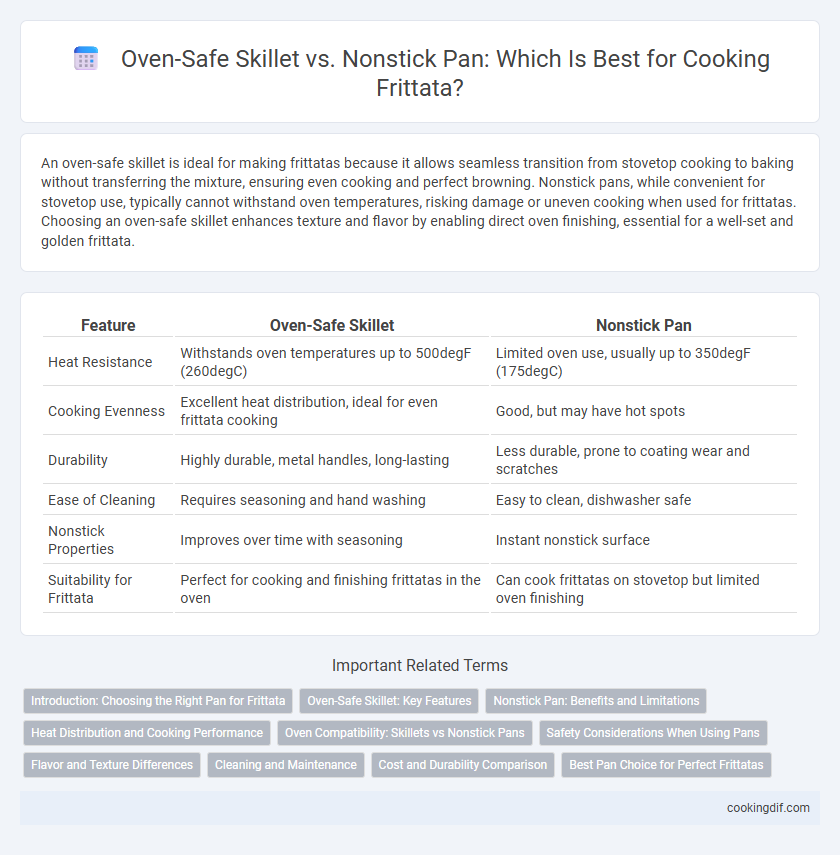An oven-safe skillet is ideal for making frittatas because it allows seamless transition from stovetop cooking to baking without transferring the mixture, ensuring even cooking and perfect browning. Nonstick pans, while convenient for stovetop use, typically cannot withstand oven temperatures, risking damage or uneven cooking when used for frittatas. Choosing an oven-safe skillet enhances texture and flavor by enabling direct oven finishing, essential for a well-set and golden frittata.
Table of Comparison
| Feature | Oven-Safe Skillet | Nonstick Pan |
|---|---|---|
| Heat Resistance | Withstands oven temperatures up to 500degF (260degC) | Limited oven use, usually up to 350degF (175degC) |
| Cooking Evenness | Excellent heat distribution, ideal for even frittata cooking | Good, but may have hot spots |
| Durability | Highly durable, metal handles, long-lasting | Less durable, prone to coating wear and scratches |
| Ease of Cleaning | Requires seasoning and hand washing | Easy to clean, dishwasher safe |
| Nonstick Properties | Improves over time with seasoning | Instant nonstick surface |
| Suitability for Frittata | Perfect for cooking and finishing frittatas in the oven | Can cook frittatas on stovetop but limited oven finishing |
Introduction: Choosing the Right Pan for Frittata
An oven-safe skillet, typically made of cast iron or stainless steel, retains heat evenly and allows seamless transfer from stovetop to oven, ensuring a perfectly cooked frittata. Nonstick pans offer easy release and simple cleanup but often lack oven durability or have temperature restrictions that can affect frittata texture and browning. Prioritizing an oven-safe skillet enhances cooking control and consistency for achieving a golden crust and fluffy interior.
Oven-Safe Skillet: Key Features
An oven-safe skillet is essential for making a perfect frittata because it can withstand high temperatures, allowing seamless stove-to-oven cooking without transferring the dish. Typically crafted from cast iron, stainless steel, or oven-safe ceramic, these skillets distribute heat evenly, resulting in a well-cooked, golden-brown crust. Unlike regular nonstick pans, oven-safe skillets maintain durability under high heat and ensure consistent cooking performance for frittatas.
Nonstick Pan: Benefits and Limitations
A nonstick pan offers easy release and simple cleanup, making it ideal for delicate frittata eggs that might otherwise stick. However, many nonstick pans are not oven-safe or have temperature limits, restricting finishing the frittata under the broiler or in the oven. Choosing a high-quality nonstick pan with a specified oven-safe rating ensures better versatility, but always verify manufacturer guidelines to prevent damage.
Heat Distribution and Cooking Performance
An oven-safe skillet, typically made of cast iron or stainless steel, offers superior heat distribution and retention, ensuring even cooking and a perfectly set frittata with a well-browned crust. Nonstick pans provide a smoother surface for easy release but often have thinner bases, leading to uneven heating and potential hot spots that can affect cooking performance and texture. Choosing an oven-safe skillet enhances heat consistency and overall frittata quality, especially when finishing the dish in the oven.
Oven Compatibility: Skillets vs Nonstick Pans
Oven-safe skillets, typically made from cast iron or stainless steel, ensure even heat distribution and maintain structural integrity under high temperatures, making them ideal for frittata preparation that requires baking. Nonstick pans often have temperature limits around 350degF to 500degF, which can restrict their oven compatibility and potentially cause coating degradation during the cooking process. Choosing an oven-safe skillet enhances durability and safety when transferring the frittata from stovetop to oven for consistent, well-cooked results.
Safety Considerations When Using Pans
Oven-safe skillets, typically made of cast iron or stainless steel, provide superior heat retention and can safely transition from stovetop to oven without risk of damage or toxic fumes. Nonstick pans, while convenient for easy release, may release harmful chemicals at high oven temperatures, limiting their oven safety and sometimes capping temperature use around 350degF (175degC). Choosing skillet materials that withstand oven heat ensures safety and maintains the integrity of the frittata during cooking.
Flavor and Texture Differences
An oven-safe skillet, typically cast iron or stainless steel, enhances frittata flavor by developing a crispy, caramelized crust and even heat distribution, producing a rich, textured finish. Nonstick pans prevent browning, resulting in a softer, less complex crust and a more uniform, tender texture. Choosing an oven-safe skillet maximizes Maillard reactions, intensifying savory notes and creating a more satisfying bite.
Cleaning and Maintenance
Oven-safe skillets, typically made from cast iron or stainless steel, require seasoning and careful cleaning to maintain their non-stick properties and prevent rust, often avoiding soap and harsh scrubbing. Nonstick pans allow for easier cleaning due to their coating, which resists food sticking, but they demand gentle handling with non-abrasive sponges to avoid damaging the surface. Both require proper maintenance, but oven-safe skillets offer durability for high heat, while nonstick pans prioritize convenience in cleaning for frittata preparation.
Cost and Durability Comparison
Oven-safe skillets, typically made from cast iron or stainless steel, offer superior durability and can withstand high temperatures, making them a long-term investment despite a higher upfront cost. Nonstick pans are usually more affordable initially but tend to wear out faster, especially when exposed to oven heat, requiring more frequent replacement. Choosing an oven-safe skillet provides better cost efficiency over time due to its extended lifespan and multipurpose use.
Best Pan Choice for Perfect Frittatas
An oven-safe skillet, preferably cast iron, ensures even heat distribution and seamless transition from stovetop to oven, crucial for achieving a perfectly cooked frittata with a golden crust. Nonstick pans offer easy release but often cannot withstand high oven temperatures, risking damage and uneven cooking. Prioritizing an oven-safe skillet enhances texture and flavor, making it the best pan choice for flawless frittatas.
Oven-safe skillet vs nonstick pan for Frittata Infographic

 cookingdif.com
cookingdif.com